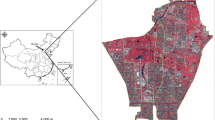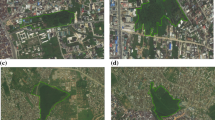Abstract
Context
Urban greenspace can significantly decrease the land surface temperature (LST). The spatial characteristics and vegetation composition of urban greenspace have a great influence on its cooling capacity.
Objectives
We sought to distinguish the cooling effect by different spatial pattern factors of greenspace and by the interaction of these factors, which may be useful in understanding cooling effect and designing urban greenspace.
Methods
Both the greenspace derived from SPOT6 and LST retrieved from Landsat-8 images are employed to identify the dominant factors influencing LST and investigate the interaction between any two dominant factors in the Beijing metropolitan area.
Results
The results indicate that the dominant spatial factors affecting LST vary by greenspace type, i.e., for grass, the number of patches (NP) and patch density (PD) have a significant effect on LST while for coniferous forest, the landscape shape index (LSI) is the dominant spatial factor. And the NP and percentage of landscape are the dominant spatial factors for broad-leaved forest and mixed forest, respectively. The interaction of any two dominant factors is larger than their individual effects, and the interaction between the NP and LSI of greenspace is not as strong as the interaction between the NP and PD.
Conclusions
Urban greenspace design and planning need to consider the spatial pattern of different types of greenspace. On this basis, we proposed a pattern effective in cooling LST in cities climatically similar to Beijing, which could provide theoretical reference for the design and planning of urban greenspace.




Similar content being viewed by others
References
Akbari H, Pomerantz M, Taha H (2001) Cool surfaces and shade trees to reduce energy use and improve air quality in urban areas. Sol Energy 70(3):295–310
Arnfield AJ (2003) Two decades of urban climate research: a review of turbulence, exchanges of energy and water, and the urban heat island. Int J Climatol 23(1):1–26
Asgarian A, Amiri BJ, Sakieh Y (2014) Assessing the effect of green cover spatial patterns on urban land surface temperature using landscape metrics approach. Urban Ecosyst 18(1):209–222
Bao TLG, Li XM, Zhang J, Zhang YJ, Tian SZ (2016) Assessing the distribution of urban green spaces and its anisotropic cooling distance on urban heat island pattern in Baotou, China. ISPRS Int J Geo-Inf 5(12):13
Baris M, Sahin S, Yazgan ME (2009) The contribution of trees and green spaces to the urban climate: the case of Ankara. Afr J Agr Res 4(9):791–800
Cao X, Onishi A, Chen J, Imura H (2010) Quantifying the cool island intensity of urban parks using ASTER and IKONOS data. Landsc Urban Plan 96(4):224–231
Chang CR, Li MH, Chang SD (2007) A preliminary study on the cool-island intensity of Taipei city parks. Landsc Urban Plan 80:386–395
Chen ZX, Su XH, Liu SZ, Gu RZ (1998) Study on ecological benefits of urban landscaping in Beijing (6). Chin Landsc Arch 14(60):53–56 (in Chinese)
Du C, Ren H, Qin Q, Meng J, Zhao S (2015) A practical split-window algorithm for estimating land surface temperature from Landsat 8 Data. Remote Sens 7(1):647–665
Estoque RC, Murayama Y, Myint SW (2017) Effects of landscape composition and pattern on land surface temperature: an urban heat island study in the megacities of Southeast Asia. Sci Total Environ 577:349–359
Feyisa GL, Dons K, Meilby H (2014) Efficiency of parks in mitigating urban heat island effect: an example from Addis Ababa. Landsc Urban Plan 123:87–95
Gao JX, Song T, Zhang B, Han YW, Gao XT, Feng CY (2016) The relationship between urban green space community structure and air temperature reduction and humidity increase in Beijing. Resour Sci 38(6):1028–1038
Ge WQ, Zhou HM, Tu DJ (2005) The surveying on thermal influence area of Shanghai urban greenbelt. Remote Sens Technol Appl 20(5):496–500 (in Chinese)
Guo L, Liu R, Men C, Wang Q, Miao Y, Zhang Y (2019a) Quantifying and simulating landscape composition and pattern impacts on land surface temperature: a decadal study of the rapidly urbanizing city of Beijing, China. Sci Total Environ 654:430–440
Guo G, Wu Z, Chen Y (2019b) Complex mechanisms linking land surface temperature to greenspace spatial patterns: evidence from four southeastern Chinese cities. Sci Total Environ 674:77–87
Huang L, Chen H, Ren H, Wang J, Guo Q (2013) Effect of urbanization on the structure and functional traits of remnant subtropical evergreen broad-leaved forests in South China. Environ Monit Assess 185(6):5003–5018
Jaganmohan M, Knapp S, Buchmann CM, Schwarz N (2016) The bigger, the better? The influence of urban green space design on cooling effects for residential areas. J Environ Qual 45(1):134–145
Ji HC (2015) Analysis on temperature change characteristics in Beijing city from 1982 to 2012. Mod Agric Sci Technol 7:259–261
Jonsson P (2004) Vegetation as an urban climate control in the subtropical city of Gaborone, Botswana. Int J Climatol 24:1307–1322
Kong FH, Sun CF, Liu FF et al (2016) Energy saving potential of fragmented green spaces due to their temperature regulating ecosystem services in the summer. Appl Energy 183:1428–1440
Kong FH, Yin HW, James P, Hutyra LR, He HS (2014) Effects of spatial pattern of greenspace on urban cooling in a large metropolitan area of eastern China. Landsc Urban Plan 128:35–47
Li JX, Song CH, Cao L, Zhu FG, Meng XL, Wu JG (2011) Impacts of landscape structure on surface urban heat islands: a case study of Shanghai, China. Remote Sens Environ 115(12):3249–3263
Li H, Wu JG (2004) Use and misuse of landscape indices. Landsc Ecol 19(4):389–399
Li XM, Zhou WQ, Ouyang ZY (2013) Relationship between land surface temperature and spatial pattern of greenspace: what are the effects of spatial resolution? Landsc Urban Plan 114:1–8
Li XM, Zhou WQ, Ouyang ZY, Xu WH, Zheng H (2012) Spatial pattern of greenspace affects land surface temperature: evidence from the heavily urbanized Beijing metropolitan area, China. Landsc Ecol 27(6):887–898
Liu FF, Yan WJ, Kong FH, Yin HW, Ban YL, Xu WB (2017) A review on the urban green space cooling effect based on field measurement of air temperature. Chin J Appl Ecol 28(4):1387–1396
Liu L, Zhang YZ (2011) Urban heat island analysis using the Landsat TM data and ASTER data: a case study in Hong Kong. Remote Sens 3(7):1535–1552
Maimaitiyiming M, Ghulam A, Tiyip T et al (2014) Effects of green space spatial pattern on land surface temperature: implications for sustainable urban planning and climate change adaptation. ISPRS J Photogramm 89:59–66
McGarigal KS, Cushman S, Neel M, Ene E (2002) FRAGSTATS: Spatial pattern analysis program for categorical maps
Oliveira S, Andrade H, Vaz T (2011) The cooling effect of green spaces as a contribution to the mitigation of urban heat: a case study in Lisbon. Build Environ 46(11):2186–2194
Park J, Kim J-H, Lee DK, Park CY, Jeong SG (2017) The influence of small green space type and structure at the street level on urban heat island mitigation. Urban For Urban Gree 21:203–212
Potchter O, Cohen P, Bitan A (2006) Climatic behavior of various urban parks during hot and humid summer in the mediterranean city of Tel Aviv, Israel. Int J Climatol 26(12):1695–1711
Ren HZ, Chen D, Liu RY et al (2015) Atmospheric water vapor retrieval from Landsat 8 thermal infrared images. J Geophys Res Atmos 120:1723–1738
Riitters KH, O’Neill RV, Hunsaker CT et al (1995) A factor analysis of landscape pattern and structure metrics. Landsc Ecol 10(1):23–39
Riva-Murray K, Riemann R, Murdoch P, Fischer JM, Brightbill R (2010) Landscape characteristics affecting streams in urbanizing regions of the Delaware River Basin (New Jersey, New York, and Pennsylvania, US). Landsc Ecol 25(10):1489–1503
Shashua-Bar L, Hoffman ME (2000) Vegetation as a climatic component in the design of an urban street: an empirical model for predicting the cooling effect of urban green areas with trees. Energy Build 31(3):221–235
Sheikhi A, Kanniah KD, Ho CH (2015) Effect of land cover and green space on land surface temperature of a fast growing economic region in Malaysia. Spie Remote Sens 9644:9644131–9644138
Shih W (2017) Greenspace patterns and the mitigation of land surface temperature in Taipei metropolis. Habitat Int 60:69–80
Voogt JA, Oke TR (2003) Thermal remote sensing of urban climates. Remote Sens Environ 86(3):370–384
Wang JF, Hu Y (2012) Environmental health risk detection with GeogDetector. Environ Modell Softw 33:114–115
Wang YQ, Li B (2016) On influence of various plants groups on changes of temperature and moisture of green land in Beijing. Shanxi Archit 42(29):196–197 (in Chinese)
Wang JF, Li XH, Christakos G et al (2010) Geographical detectors-based health risk assessment and its application in the neural tube defects study of the Heshun Region, China. Int J Geogr Inf Sci 24(1):107–127
Wang JF, Xu CD (2017) Geodetector: principle and prospective. Acta Geogr Sin 72(1):116–134
Watkins R (2002) The impact of the urban environment on the energy used for cooling buildings. In: International conference on nuclear engineering
Xiang Y, Yu HY, Luo YY, Yang M (2010) Exploration on the edge effect and its influence of urban public green space. Nor Hortic 4:109–112 (in Chinese)
Yang J, Sun J, Ge QS, Li XM (2017) Assessing the impacts of urbanization-associated green space on urban land surface temperature: a case study of Dalian, China. Urban For Urban Gree 22:1–10
Zhang XY, Zhong TY, Feng XZ, Wang K (2009) Estimation of the relationship between vegetation patches and urban land surface temperature with remote sensing. Int J Remote Sens 30(8):2105–2118
Zhou WQ, Huang GL, Cadenasso ML (2011) Does spatial configuration matter? Understanding the effects of land cover pattern on land surface temperature in urban landscapes. Landsc Urban Plan 102(1):54–63
Zoran M (2008) Satellite observation of biophysical indicators related to urban heat island effect. In: 37th COSPAR scientific assembly, Montréal, Canada, p A31-0086-08
Zoulia I, Santamouris M, Dimoudi A (2009) Monitoring the effect of urban green areas on the heat island in Athens. Environ Monit Assess 156(1–4):275–292
Acknowledgements
This work was funded by the National Key Research and Development Program of China (Nos. 2018YFC1406906, and 2016YFA0600104) and Top-Notch Young Talents Program of China (to Shen).
Author information
Authors and Affiliations
Corresponding authors
Ethics declarations
Conflict of interest
The authors declare no conflict of interest.
Additional information
Publisher's Note
Springer Nature remains neutral with regard to jurisdictional claims in published maps and institutional affiliations.
Electronic supplementary material
Below is the link to the electronic supplementary material.
Rights and permissions
About this article
Cite this article
Yin, J., Wu, X., Shen, M. et al. Impact of urban greenspace spatial pattern on land surface temperature: a case study in Beijing metropolitan area, China. Landscape Ecol 34, 2949–2961 (2019). https://doi.org/10.1007/s10980-019-00932-6
Received:
Accepted:
Published:
Issue Date:
DOI: https://doi.org/10.1007/s10980-019-00932-6




